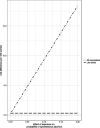Environmental hazards, social inequality, and fetal loss: Implications of live-birth bias for estimation of disparities in birth outcomes
- PMID: 33870007
- PMCID: PMC8043739
- DOI: 10.1097/EE9.0000000000000131
Environmental hazards, social inequality, and fetal loss: Implications of live-birth bias for estimation of disparities in birth outcomes
Abstract
Restricting to live births can induce bias in studies of pregnancy and developmental outcomes, but whether this live-birth bias results in underestimating disparities is unknown. Bias may arise from collider stratification due to an unmeasured common cause of fetal loss and the outcome of interest, or depletion of susceptibles, where exposure differentially causes fetal loss among those with underlying susceptibility.
Methods: We conducted a simulation study to examine the magnitude of live-birth bias in a population parameterized to resemble one year of conceptions in California (N = 625,000). We simulated exposure to a non-time-varying environmental hazard, risk of spontaneous abortion, and time to live birth using 1000 Monte Carlo simulations. Our outcome of interest was preterm birth. We included a social vulnerability factor to represent social disadvantage, and estimated overall risk differences for exposure and preterm birth using linear probability models and stratified by the social vulnerability factor. We calculated how often confidence intervals included the true point estimate (CI coverage probabilities) to illustrate whether effect estimates differed qualitatively from the truth.
Results: Depletion of susceptibles resulted in a larger magnitude of bias compared with collider stratification, with larger bias among the socially vulnerable group. Coverage probabilities were not adversely affected by bias due to collider stratification. Depletion of susceptibles reduced coverage, especially among the socially vulnerable (coverage among socially vulnerable = 46%, coverage among nonsocially vulnerable = 91% in the most extreme scenario).
Conclusions: In simulations, hazardous environmental exposures induced live-birth bias and the bias was larger for socially vulnerable women.
Keywords: Environmental hazard; fetal loss; health disparities; live-birth bias; miscarriage; perinatal health; preterm birth; selection bias; spontaneous abortion.
Copyright © 2021 The Authors. Published by Wolters Kluwer Health, Inc. on behalf of The Environmental Epidemiology. All rights reserved.
Figures









Similar articles
-
Bias due to Selection on Live Births in Studies of Environmental Exposures during Pregnancy: A Simulation Study.Environ Health Perspect. 2021 Apr;129(4):47001. doi: 10.1289/EHP7961. Epub 2021 Apr 1. Environ Health Perspect. 2021. PMID: 33793300 Free PMC article.
-
Bias from restricting to live births when estimating effects of prescription drug use on pregnancy complications: A simulation.Pharmacoepidemiol Drug Saf. 2018 Mar;27(3):307-314. doi: 10.1002/pds.4387. Epub 2018 Jan 17. Pharmacoepidemiol Drug Saf. 2018. PMID: 29341340
-
Endometrial injection of embryo culture supernatant for subfertile women in assisted reproduction.Cochrane Database Syst Rev. 2020 Aug 14;8(8):CD013063. doi: 10.1002/14651858.CD013063.pub2. Cochrane Database Syst Rev. 2020. PMID: 32797689 Free PMC article.
-
Low anti-Müllerian hormone level is not a risk factor for early pregnancy loss in IVF/ICSI treatment.Hum Reprod. 2020 Mar 27;35(3):504-515. doi: 10.1093/humrep/deaa008. Hum Reprod. 2020. PMID: 32219343
-
Bias from conditioning on live birth in pregnancy cohorts: an illustration based on neurodevelopment in children after prenatal exposure to organic pollutants.Int J Epidemiol. 2015 Feb;44(1):345-54. doi: 10.1093/ije/dyu249. Epub 2015 Jan 19. Int J Epidemiol. 2015. PMID: 25604449 Free PMC article. Review.
Cited by
-
Hurricane Harvey and the risk of spontaneous preterm and early-term birth.Environ Epidemiol. 2024 May 17;8(3):e312. doi: 10.1097/EE9.0000000000000312. eCollection 2024 Jun. Environ Epidemiol. 2024. PMID: 38799265 Free PMC article.
-
School-age outcomes among IVF-conceived children: A population-wide cohort study.PLoS Med. 2023 Jan 24;20(1):e1004148. doi: 10.1371/journal.pmed.1004148. eCollection 2023 Jan. PLoS Med. 2023. PMID: 36693021 Free PMC article. Clinical Trial.
-
Susceptible windows of exposure to fine particulate matter and fetal growth trajectories in the Spanish INMA (INfancia y Medio Ambiente) birth cohort.Environ Res. 2023 Jan 1;216(Pt 2):114628. doi: 10.1016/j.envres.2022.114628. Epub 2022 Oct 21. Environ Res. 2023. PMID: 36279916 Free PMC article.
-
Residential proximity to hydraulically fractured oil and gas wells and adverse birth outcomes in urban and rural communities in California (2006-2015).Environ Epidemiol. 2021 Oct 13;5(6):e172. doi: 10.1097/EE9.0000000000000172. eCollection 2021 Dec. Environ Epidemiol. 2021. PMID: 34909552 Free PMC article.
-
Occurrence of fatal police violence during pregnancy and hazard of preterm birth in California.Paediatr Perinat Epidemiol. 2021 Jul;35(4):469-478. doi: 10.1111/ppe.12753. Epub 2021 Mar 10. Paediatr Perinat Epidemiol. 2021. PMID: 33689194 Free PMC article.
References
-
- Parazzini F, Chatenoud L, Tozzi L, Benzi G, Dal Pino D, Fedele L. Determinants of risk of spontaneous abortions in the first trimester of pregnancy. Epidemiology. 1997; 8:681–683. - PubMed
Grants and funding
LinkOut - more resources
Full Text Sources
Other Literature Sources
